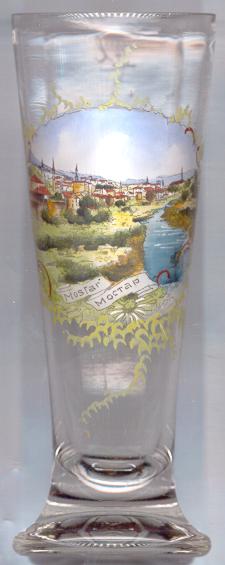

|
| BOSNA i HERCEGOVINA | BOSNIA and HERZEGOVINA |
| entitet: Federacija Bosne i Hercegovine | entity: Federation of Bosnia and Herzegovina |
| Kanton: Hercegovačko-Neretvanski |
 Mostar is situated on the Neretva river in
southwestern Bosnia and Herzegovina, and is the main city of Herzegovina. The
history of Mostar goes back to the 15th century. The first mentionings in
documents date from 1452 and 1469. In the first document it is described as a
settlement at a wooden bridge strenghtened by chains and fortified by two
towers. In the latter document, the name Mostar appears for the first time. It
is derived either from mostari, the bridge keepers, or from mostare,
the bridge towers. After Bosnia lost its independence to the Ottoman empire in
1463, Herzegovina and Mostar fell in 1483. During the next 400 years of Ottoman
rule, Bosnia's and Herzegovinas's towns and cities were lavished with splendid
mosques, schools and libraries by the Sultans and the local governors. Bosnia
and Herzegovina were occupied by Austria-Hungary in 1878, annexed in 1908, and
remained part of the Habsburg monarchy until 1918.
The Old Bridge area of the old city of Mostar was listed as a UNESCO World Heritage site in 2005.
(see also list of other UNESCO heritage sites depicted on glasses of this collection)
Mostar is situated on the Neretva river in
southwestern Bosnia and Herzegovina, and is the main city of Herzegovina. The
history of Mostar goes back to the 15th century. The first mentionings in
documents date from 1452 and 1469. In the first document it is described as a
settlement at a wooden bridge strenghtened by chains and fortified by two
towers. In the latter document, the name Mostar appears for the first time. It
is derived either from mostari, the bridge keepers, or from mostare,
the bridge towers. After Bosnia lost its independence to the Ottoman empire in
1463, Herzegovina and Mostar fell in 1483. During the next 400 years of Ottoman
rule, Bosnia's and Herzegovinas's towns and cities were lavished with splendid
mosques, schools and libraries by the Sultans and the local governors. Bosnia
and Herzegovina were occupied by Austria-Hungary in 1878, annexed in 1908, and
remained part of the Habsburg monarchy until 1918.
The Old Bridge area of the old city of Mostar was listed as a UNESCO World Heritage site in 2005.
(see also list of other UNESCO heritage sites depicted on glasses of this collection)
![[scale]](lineal.jpg)